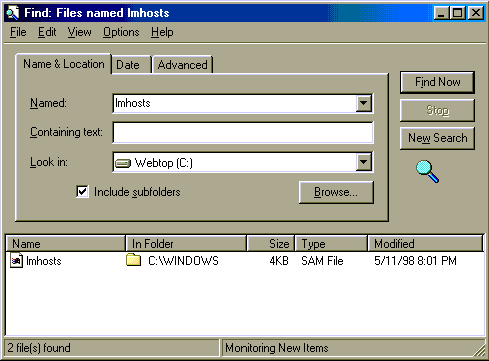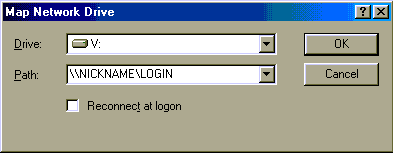SMB is a file sharing protocol designed to allow you to treat remote file systems, such as your Virtual Private Server, as if they were on your local computer. If your PC uses an O/S (such as Microsoft Windows) that supports SMB file sharing, you can map a drive letter connection to your Virtual Private Server.
Samba
![]() Samba is an SMB program that runs on UNIX servers such as your Virtual Private Server which allows you to create SMB connections to your local PC. Samba is configured and running on the system level of your server, and should not require any server-side maintenence or configuration.
Samba is an SMB program that runs on UNIX servers such as your Virtual Private Server which allows you to create SMB connections to your local PC. Samba is configured and running on the system level of your server, and should not require any server-side maintenence or configuration.
Configuring Your Windows PC
There are several steps involved in preparing your Windows PC to be able to create an SMB connection to your Virtual Private Server. The following instructions assume you already have a working Internet connection on a PC running a Microsoft Windows O/S (95, 98, 2000, me, or XP).
-
Create or update your Windows lmhosts file
Locate and modify a file titled lmhosts in your C:\Windows directory. If the file does not exist then you will need to create it. In some revisions of Windows a sample lmhosts file is included with the software installation. You can search for the existence of this sample file by using one of two methods. One way to find the file is simply by using your Windows Explorer to review the contents of your C:\Windows directory; looking specifically for a filename like lmhosts.sam. You can also search for the file by using the search capability in your Start menu.

If you find the file lmhosts.sam, open the file using Notepad or some other text file editor. If you did not find the file, then launch Notepad to create a new file. Add a line to the bottom of the file you have just opened. The line should contain the IP address of your Virtual Private Server and a nickname that you would like to identify the IP address with, for example:
1.2.3.4 nickname 111.222.111.222 "Virtual Private Server"Note that if the nickname you choose includes a space or other special characters, you will need to enclose the nickname with quotation marks. If you are administrating multiple Virtual Private Server accounts, then you will need to specify a unique nickname for each IP address you include. Also, make sure that each host entry ends with a line feed. ress your enter key a couple of times after the last entry in your lmhosts file just to be safe.
After you have finished adding the lines to your file, save it to your C:\Windows directory with the name lmhosts. Most windows editors will want you to specify a file extension like .txt or .doc. You can prevent this from happening by enclosing the filename in quotation marks.
-
Enable plain text passwords
Depending upon the version of Windows you are running, you may need to update your system registry in order to enable plain text passwords.-
Windows 2000/XP
The system registry must be updated. Download and run the following program, which will automatically update the registry for you. -
Windows 98/Me
The system registry must be updated. In the Start Menu select Run.... This will bring up a Run window with a text entry field. Type regedit and hit Ok. This will bring up the Registry Editor. Select the following folders:Windows 98
expand HKEY_LOCAL_MACHINE
then expand System
then expand CurrentControlSet
then expand Services
then expand VxD
then select VNETSUPWindows Me
expand HKEY_LOCAL_MACHINE
then expand System
then expand CurrentControlSet
then expand Services
then expand Rdr
then select ParametersOn the right hand side you will see a collection of name:data pairs. To add a new entry here for EnablePlainTextPassword, select the Edit menu, then select New, then DWORD Value. This will create a new name:data pair. Change the name from the default New Value #1 to EnablePlainTextPassword. The name:data pair should now look like:
EnablePlainTextPassword 0x00000000 (0)
Highlight the EnablePlainTextPassword and then select the Edit menu and the Modify menu item (it should be the first menu item). In the Edit DWORD Value dialog box change the Value data value from 0 to 1 and make sure the Hexadecimal radio button is selected. Then select the Ok dialog. Exit the Registry Editor.
-
Windows 95
Plain text passwords are enabled by default. No action is necessary.
-
-
Change your local username
If you are using Windows 95 or 98, your Windows login name must match the login name of your Virtual Private Server. Windows NT, 2000, Me, and XP all allow you to define a separate username for remote connections so this step is not necessary. -
Restart your Windows PC
-
Map a Windows network drive to your Virtual Private Server
Now that you have included IP address/nickname pairs in your lmhosts file, you are reading to establish network connections using the File Sharing capability. To do this, open your Windows Explorer and select the Map Network Drive... menu item located in the Tools menu. This will open up the Map Network Drive dialog box. If you don't see the Map Network Drive... option, you may need to modify your folder view settings to display the option.Using the Map Network Drive dialog, you will map a specific drive letter to the File Sharing Connection. Select an available drive letter using the Drive: selection box. The value for the Path: definition should be of the form \\NICKNAME\LOGIN, where NICKNAME is one of the nicknames you defined for a specific IP address in your lmhosts file and LOGIN is the login id for the Virtual Private Server at that IP address.

For example, if you defined the nickname Virtual Private Server for the IP address of your Virtual Private Server account and the login id for your account was biff, then you would enter \\Virtual Private Server\biff as the value in the Path: text entry field. If you would like the drive mapped each time you logon to your computer then select the Reconnect at logon check box.
Select the OK button after you have selected a Drive letter and specified a path. Your computer will then attempt to map the drive to the home directory of your Virtual Private Server. This process can take several minutes so please be patient. If a connection is established, you will be prompted for your login password. After you enter your password and successfully authenticate, your Windows Explorer will display the drive letter on the left-hand side along with your local drives. You can now double-click on directories to expand paths and double-click on files to open them locally. If you need to upload files to a specific directory, you need only drag the file from your local folder to your Virtual Private Servers folder. Likewise, if you want to download a file to your local machine, you would select the file in your Virtual Private Servers folder and drag it to your desktop or a local file folder.
NOTE: Because UNIX uses a different EOL (End Of Line) scheme than DOS/Windows you will need to translate any text (html, perl script, etc.) files before copying them up to your Virtual Private Server. UNIX text files have lines delimited by a single line-feed character (0A hex), whereas DOS text-mode files are delimited with a carriage-return/line-feed pair (0D/OA hex). We have placed a very useful utility, fixcrlf, that you can install on your Windows PC to do help convert DOS files to UNIX and UNIX files to DOS. Using fixcrlf you simply drag-and-drop your file on to the fixcrlf dialog. It automatically detects which the ASCII file type and makes the proper conversion. Please note that binary files do not need to be converted.
Tip: There are many advanced text editors and Web Page design tools that are UNIX aware, and can save files in a UNIX text file format. This way you don't have to worry about converting the file before uploading your content. You can then edit your content directly on your Virtual Private Server without the need to save it locally.
Please note: the information on this page applies to ITS web hosting plans. It may or may not apply to other environments. If you are looking for a feature described here, or better support from your hosting provider, please consider hosting your site with ITS!
Copyright © 1996-2025, Integrated Technical Solutions, Inc., all rights reserved. See Terms/Legal for trademarks, copyright, and terms of use.
Naperville, IL 60563
fax 630.420.2771
